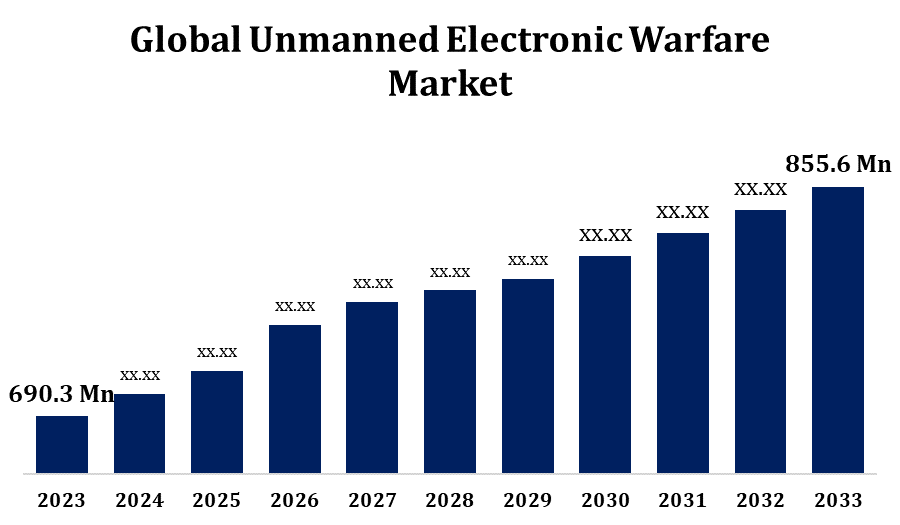Global Unmanned Electronic Warfare Market Size To Worth USD 855.6 Million By 2033 | CAGR Of 2.17%
Category: Aerospace & DefenseGlobal Unmanned Electronic Warfare Market Size To Worth USD 855.6 Million By 2033
According to a research report published by Spherical Insights & Consulting, The Global Unmanned Electronic Warfare Market Size to Grow from USD 690.3 Million in 2023 to USD 855.6 Million By 2033, at a Compound Annual Growth Rate (CAGR) of 2.17% during the forecast period.

Get more details on this report -
Browse key industry insights spread across 240 pages with 141 Market data tables and figures & charts from the report on the "Global Unmanned Electronic Warfare Market Size, Share, and COVID-19 Impact Analysis, by Product (Unmanned EW Equipment, Unmanned EW Operational Support), by Operation (Semi-autonomous, Fully Autonomous), by Platform (Unmanned Aerial Vehicles, Unmanned land Vehicles, Unmanned Marine vehicles), and By Region (North America, Europe, Asia-Pacific, Latin America, Middle East, and Africa), Analysis and Forecast 2023 - 2033." Get Detailed Report Description Here: https://www.sphericalinsights.com/reports/unmanned-electronic-warfare-market
The unmanned electronic warfare (EW) market is growing rapidly, driven by increasing defense budgets, technological advancements, and escalating geopolitical tensions. Unmanned systems, such as drones and autonomous vehicles, are being equipped with EW capabilities for intelligence gathering, jamming, and countermeasure operations, enhancing battlefield effectiveness while reducing human risk. Key growth factors include rising demand for electronic intelligence (ELINT), signals intelligence (SIGINT), and cyber warfare solutions. The integration of artificial intelligence (AI) and machine learning is further advancing autonomous EW operations. North America leads the market, with substantial investments from the U.S. Department of Defense, while Asia-Pacific is emerging as a key growth region. However, cybersecurity risks and regulatory constraints may hinder expansion. Major industry players include Lockheed Martin, Northrop Grumman, and BAE Systems.
Unmanned Electronic Warfare Market Value Chain Analysis
The unmanned electronic warfare (EW) market value chain comprises several interconnected segments, including component suppliers, system integrators, software developers, service providers, and end users. Component suppliers deliver essential technologies such as sensors, antennas, jamming devices, and communication modules. System integrators, primarily defense contractors, assemble these components into unmanned EW platforms like drones and autonomous systems. Software developers design advanced algorithms for electronic attack, defense, and support functions, while service providers offer maintenance, training, and cybersecurity solutions. End users mainly consist of defense agencies, intelligence organizations, and homeland security departments. Effective collaboration among these stakeholders ensures seamless integration and operational efficiency. While challenges such as supply chain disruptions and cybersecurity threats persist, innovations in artificial intelligence (AI) and software-defined EW systems continue to drive market advancements.
Unmanned Electronic Warfare Market Opportunity Analysis
The unmanned electronic warfare (EW) market offers substantial growth opportunities fueled by increasing defense budgets, geopolitical tensions, and advancements in autonomous technologies. The growing reliance on unmanned aerial vehicles (UAVs) and autonomous systems for electronic attack, signals intelligence (SIGINT), and cyber warfare is driving demand for advanced EW solutions. Emerging markets in Asia-Pacific and the Middle East present expansion prospects due to ongoing military modernization efforts. The integration of artificial intelligence (AI) and machine learning enhances real-time decision-making, boosting operational efficiency. Additionally, innovations in software-defined EW systems and miniaturized jamming technologies are unlocking new possibilities. However, addressing cybersecurity risks and regulatory constraints remains essential. Companies investing in AI-powered, networked EW systems will gain a competitive advantage in this rapidly evolving sector.
The increasing adoption of unmanned warfare systems is driven by rising transnational and regional security threats, accelerating growth in the unmanned electronic warfare (EW) market. Nations are investing heavily in autonomous EW platforms, such as drones and unmanned ground vehicles, to strengthen surveillance, electronic attack, and cyber defense capabilities. These systems offer strategic advantages by minimizing human risk and enabling real-time threat mitigation. The integration of artificial intelligence (AI), machine learning, and software-defined EW technologies further enhances operational effectiveness. Key factors fueling growth include expanding defense budgets, military modernization initiatives, and rising demand for electronic intelligence (ELINT) and signals intelligence (SIGINT). While North America leads in adoption, fast-growing markets in Asia-Pacific and the Middle East present significant opportunities for industry players.
Cybersecurity vulnerabilities present a major risk, as adversaries may hack or disrupt unmanned systems, jeopardizing missions. Regulatory and compliance challenges also constrain market growth, with strict defense policies and export restrictions limiting technology transfer. The high costs associated with developing and maintaining advanced EW systems create financial constraints for some nations. Additionally, interoperability issues emerge when integrating unmanned EW platforms with existing defense networks. The growing dependence on artificial intelligence (AI) and machine learning raises concerns about system reliability and ethical considerations. Supply chain disruptions, including shortages of critical components like semiconductors, further hinder production and deployment, posing challenges to the industry's expansion.
Insights by Platform
The unmanned aerial vehicle segment accounted for the largest market share over the forecast period 2023 to 2033. The growth is driven by the rising demand for aerial electronic attack, surveillance, and signals intelligence (SIGINT) operations. UAVs equipped with electronic warfare (EW) capabilities enhance real-time battlefield awareness, electronic jamming, and cyber warfare while minimizing risks to human operators. Advances in artificial intelligence (AI) and machine learning are further enhancing autonomous decision-making and threat response. The integration of software-defined radios and next-generation jamming technologies increases UAV effectiveness in contested environments. Nations worldwide, particularly the U.S., China, and Israel, are making significant investments in UAV-based EW platforms to strengthen their defense capabilities.
Insights by Product
The unmanned EW equipment segment accounted for the largest market share over the forecast period 2023 to 2033. The growth is driven by the increasing demand for advanced electronic attack, surveillance, and cyber defense solutions. Key equipment includes electronic jammers, radar warning receivers, electronic countermeasure (ECM) systems, and signals intelligence (SIGINT) payloads integrated into unmanned platforms such as drones and autonomous vehicles. Advancements in software-defined radios, artificial intelligence (AI), and miniaturized EW technologies are enhancing operational efficiency. Nations worldwide, particularly the U.S., China, and European countries, are investing in state-of-the-art EW equipment to counter emerging threats. Additionally, the growing adoption of network-centric warfare and swarm-based EW operations is further fueling demand for these advanced systems.
Insights by Operation
The Fully Autonomous segment accounted for the largest market share over the forecast period 2023 to 2033. Growth is driven by advancements in artificial intelligence (AI), machine learning, and autonomous decision-making capabilities. These systems minimize human intervention in electronic attack, signals intelligence (SIGINT), and cyber warfare operations, allowing for faster threat detection and response. Fully autonomous EW platforms enhance mission effectiveness by operating in high-risk environments without direct human control. Nations such as the U.S., China, and Russia are making significant investments in autonomous EW systems to maintain a strategic advantage. The integration of AI-powered data processing and adaptive electronic countermeasures further enhances operational efficiency, reinforcing the role of autonomy in modern electronic warfare.
Insights by Region

Get more details on this report -
North America is anticipated to dominate the Unmanned Electronic Warfare Market from 2023 to 2033. The U.S. Department of Defense (DoD) is at the forefront of developing and deploying autonomous electronic warfare (EW) systems for intelligence gathering, electronic attacks, and cyber warfare. Leading defense contractors, including Lockheed Martin, Northrop Grumman, and Raytheon Technologies, are investing in AI-powered, software-defined EW solutions to improve mission effectiveness. The increasing emphasis on countering emerging threats, such as cyberattacks and electronic jamming, is further driving demand. Additionally, partnerships between defense agencies and private sector firms are fostering innovation in unmanned EW platforms, accelerating advancements in next-generation warfare technologies.
Asia Pacific is witnessing the fastest market growth between 2023 to 2033. Growth is driven by escalating regional security threats, military modernization efforts, and increasing defense budgets. Developing nations are making significant investments in autonomous electronic warfare (EW) capabilities to enhance electronic attack, signals intelligence (SIGINT), and cyber warfare operations. China is leading in indigenous development, while India is bolstering its defense sector through collaborations and initiatives such as "Make in India." Meanwhile, Japan and South Korea are advancing AI-driven EW solutions to address evolving threats. Rising tensions in the South China Sea and the broader Indo-Pacific region are further fueling demand for unmanned EW systems, reinforcing their strategic importance in modern defense operations.
Recent Market Developments
- In March 2021, Lockheed Martin Corporation and Northrop Grumman Corporation received contracts from the U.S. Missile Defense Agency (MDA) for the Next Generation Interceptor (NGI) program. Similarly, in April 2020, Lockheed Martin Corporation secured a USD 75 million contract from the U.S. Army to develop, produce, and test operational electronic warfare (EW) pods.
Major players in the market
- Lockheed Martin Corporation (US)
- Northrop Grumman Corporation (US)
- Thales Group (France)
- Leonardo SPA (Italy)
- Saab AB (Sweden)
- BAE Systems (UK)
- Aselsan AS (Turkey)
- Elbit Systems (Israel)
- L3 Harris Technologies (US)
Market Segmentation
This study forecasts revenue at global, regional, and country levels from 2023 to 2033.
Unmanned Electronic Warfare Market, Product Analysis
- Unmanned EW Equipment
- Unmanned EW Operational Support
Unmanned Electronic Warfare Market, Operation Analysis
- Semi-autonomous
- Fully Autonomous
Unmanned Electronic Warfare Market, Platform Analysis
- Unmanned Aerial Vehicles
- Unmanned land Vehicles
- Unmanned Marine vehicles
Unmanned Electronic Warfare Market, Regional Analysis
- North America
- US
- Canada
- Mexico
- Europe
- Germany
- Uk
- France
- Italy
- Spain
- Russia
- Rest of Europe
- Asia Pacific
- China
- Japan
- India
- South Korea
- Australia
- Rest of Asia Pacific
- South America
- Brazil
- Argentina
- Rest of South America
- Middle East & Africa
- UAE
- Saudi Arabia
- Qatar
- South Africa
- Rest of the Middle East & Africa
About the Spherical Insights & Consulting
Spherical Insights & Consulting is a market research and consulting firm which provides actionable market research study, quantitative forecasting and trends analysis provides forward-looking insight especially designed for decision makers and aids ROI.
Which is catering to different industry such as financial sectors, industrial sectors, government organizations, universities, non-profits and corporations. The company's mission is to work with businesses to achieve business objectives and maintain strategic improvements.
CONTACT US:
For More Information on Your Target Market, Please Contact Us Below:
Phone: +1 303 800 4326 (the U.S.)
Phone: +91 90289 24100 (APAC)
Email: inquiry@sphericalinsights.com, sales@sphericalinsights.com
Contact Us: https://www.sphericalinsights.com/contact-us
Need help to buy this report?